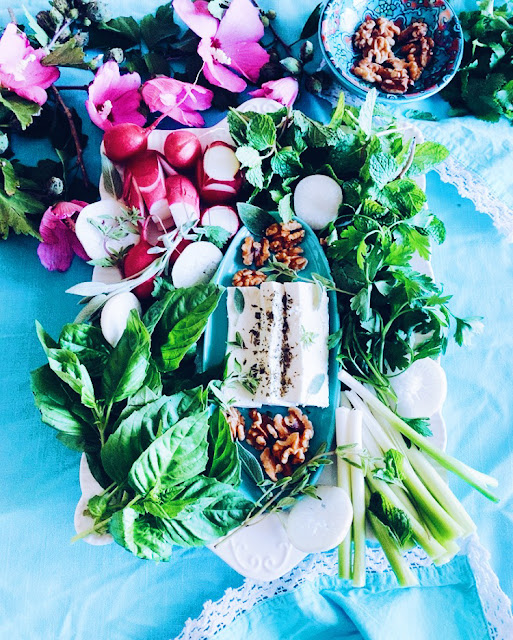A traditional Persian plate of fresh herbs usually consists of basil (rayhan), mint (naana), tarragon (tarkhoon), chives (tareh), radish (torob-cheh), scallion (piaz-cheh), cilantro (geshniz), parsley (jafari), dill (shevid), and Iranian watercress (shaahi). For many of us who live outside of Iran and who may not be able to find the exact herbs that we are used to, we've learned to substitute. For example, instead of using "tareh", I use chives in sabzi khordan, and in cooking, I use the green part of scallions or leeks whenever the recipe calls for "tareh."
Typically, a platter of washed and trimmed herbs is placed on the table and is passed around for each person to take a handful. This aromatic, flavorful, and nutritious side enhances the taste of any dish including all Iranian polow and khoresh dishes, kababs, and kotlets.
نون و پنیر و سبزی Noon paneer sabzi consists of fresh herbs served with feta cheese and flatbread like lavash or pita bread. To me, this herb, cheese, and warm bread with the addition of walnuts is a perfect meal all by itself. This is a healthy, light, and tasty meal with no cooking involved! What more can you ask for?
Ingredients:
Use a bunch of each of the following herbs. Create your own combination.
Basil (ریحان )
Chives (تره)
Cilantro (گشنیز)
Mint (نعنا)
Parsley (جعفری)
Scallions (پیازچه)
Tarragon (ترخون)
Radishes (تربچه)
Watercress (شاهی)
Sliced Feta cheese (پنیر)
1/2 cup walnuts (گردو)
Flat Bread (نان)
Method:
- Trim the herbs, remove the stems of parsley, cilantro, basil and mint. Remove the leaves of radishes and the green parts of the scallions, (you may serve them if desired). Make sure every herb is trimmed into small and bite-size pieces.
- Rinse all herbs thoroughly including packaged herbs.
- Place the washed herbs in a colander and drain.
- Place the herbs on a platter and serve with feta cheese, walnuts and warm bread.
Enjoy!













